 Legoaizer -
Help Legoaizer -
Help |
 Legoaizer -
Help
Legoaizer -
Help
User interface
Legoaizer
is easy to use. Basically there are two types of controls: buttons that show
a dedicated functional window, and the main menu bar on top. In
addition, the status bar at the bottom shows some actual information; the menu has
additional input and output controls. The Graphical User
Interface (GUI)
On top
you find as usual the main menu bar, o the left side you find 8
functional buttons; top-left the source picture is shown; in
the middle a large space is shown for the mosaic result picture (an
empty 'chessboard' at start); and finally on the right you find the
colour palette of the loaded brick-colour set. At the bottom you find
the status bar with information. On the left you find the name of the
loaded dataset (e.g. 'LegoNoFiles') and the current mosaic size in cm or inches.
On the right you see the date and time, and the selector in which unit you are
working (metric or inches). Finally the start button
to create the mosaic is
placed bottom left in the GUI.
Some
functional buttons are greyed out at start. These will be enabled after a
mosaic has been generated,
and when
a full valid (full) license was
found (e.g. Mondriaan and the Builder will be disabled for non-licensed users, but only
after the Grace Day period has expired). The icons on the left are actually buttons. When
you click on them a small window is opened, depending on the button the content
is refreshed with their functions. In some cases not a window of functions is
opened, but a dialog is opened, e.g. to open or create a picture library or a
set editor is created. The datasets are created on the fly, based on the current
selection of available colours and bricks/parts. For that reason these editors
take a few seconds to be created On top the main menu is shown, with the basic
controls for file management, exporting and colour/data tables. Also some tools
are available, like license information and skin and language selection.
Finally, on the top of the main viewer (the one that will show the
mosaic result) the cost estimation is shown. The information is retrieved from
the database numbers. It's the responsibility of the user to make sure these
cost numbers are accurate and complete. Zoom
bar The
little arrow on the left The
menu Picture above: the File commands in the menu.
Most conveniently the last opened 8 picture
files are remembered. Also other functionality is available, e.g. the resulting mosaic
can be printed, saved in a specific location; and the video
file can be saved.
This is
the full menu,
each with a short description:
The functional buttons
The colour selector Some buttons The follow-me text
option The status
bar
Picture above: the Status bar. On the right you see
the 'Metric' button. This sets
the metrics in the application: cm or inches. This setting is remembered upon
application exit; when metric is chosen the default print size ratio follows A4, while with inches the default
print ratio follows Letter (8.5 x 11 inch). The
real print size is defined when actually printing to the printer. Also
for pdf printing (e.g. using CutePDF) the print size is determined by the
destination file paper size settings.
At start the interface has several functional
areas. See picture below. 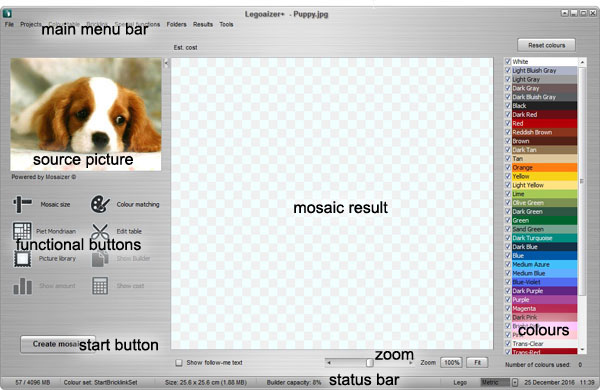
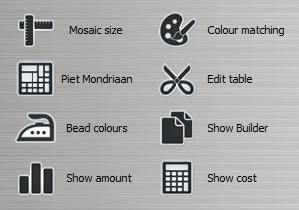

The large center mosaic
window has a couple of zoom controls. These are use to zoom in and out to
inspect and evaluate the quality and details of the mosaic blueprint. Especially
when the details of bricks placement and stability (e.g. interlocking of
Ministeck® parts) are inspected, this zoom function is helpful. 
A little arrow can be found next to the source picture on
its right. This arrow is a button, and when pressed the functional buttons and the source
picture will be hidden from the main window. This way the user can fully
study and use the main result viewer, with zoom etc functions. When this button
is clicked again the left part of the screen is made visible again.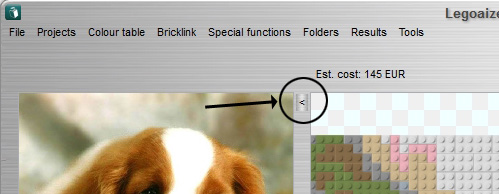
The menu is mainly used for
input and output, and also contains some useful tools. Most menu functions speak for themselves, or are
sufficiently explained in the chapter of the GUI. Some features are also
explained in more detail in this chapter. In all cases when the application is
closed all the relevant settings are stored as well.
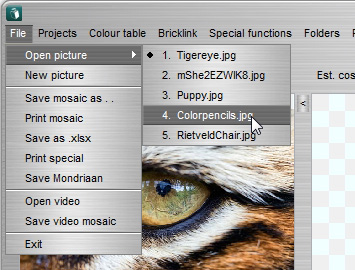

On the right the currently
available colours are shown. These colours are represented by checkboxes. At
start all the colours are checked, meaning: they are taken into the colour
selection of the mosaic. When a mosaic is created, only the colours that are
checked are taken into the colour-brick palette. Unchecked colours stay visible.
Only when the current set is saved as a new colour table, only the active
colours are shown. For that reason the original 'LegoNoFile.xml' should
never
be overwritten.
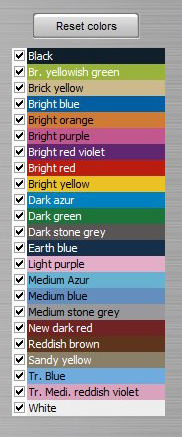
There are
just two 'real' buttons in
the main GUI. By pressing the 'Create
mosaic' button
(obviously) the mosaic is created with the currently
available settings and values. The other button 'Reset
colours' is used to reset the colour table on the right, basically checking
all the tick-boxes again. This way the colour palette is quickly reset. In case a
different source picture, colour table or colour matching engine is selected this
table is automatically reset.
When you check the option 'Show
follow-me text'
the cursor will show the nearest brick information: colour and size. This
is identical to a similar option in the mosaic brick Builder. However,
in case you have created a sideways mosaic (see here for details), the Builder will only show
1-stud bricks only. That is caused by the internal building and brick data
management. So, when you open the Builder of a sideway mosaic you will notice
that e.g. a 2x2 brick is now shown as 2x1 brick. No worries, the data is OK and
the blueprint excel file is correct. But technically you have a 1-stud high
brick when showing the mosaic sideways.
